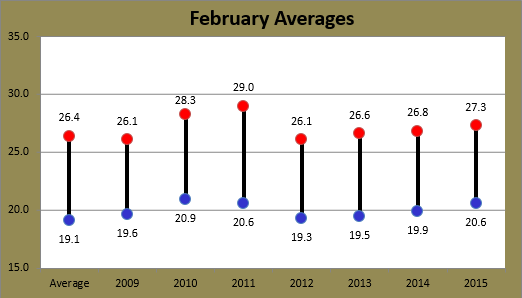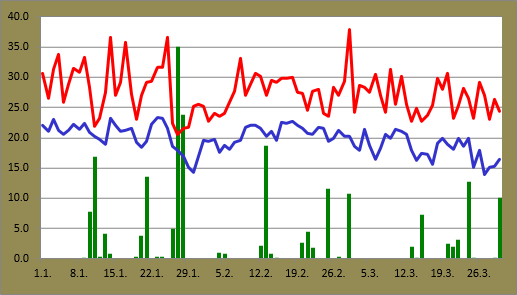The averages at Sydney Airport for the past few Februaries can be seen below.
 |
| February averages at Sydney Airport for the period 2009-2015 plus the long term average |
The average minimum of 20.6C was the equal second highest in the years since 2009. The Bureau of Meteorology recorded the same figure and according to their records, it is the eighth highest since 1940. The average maximum was also the highest of the past four years, but cooler than both 2010 and 2011 and not within the top 10% of figures on record.
The highest temperature of the month was fairly low for February's standards. It reached 33.1C on the 8th. 2013 did, however, record a lower respective figure of 31.0C. The coolest day was a part of the cool summer period extending from January. The 22.7C maximum on February 2 was, however, the equal third highest such figure on record.
The coldest temperature was 17.6C on February 4. Only 2010 had a figure higher than that since 2009. It is actually the fifth highest such figure on record. The highest minimum came on the 18th. It never went below 22.8C then. This figure was in the middle of those for recent years.
The return to more typical summer temperatures came on February 7 when it rose above 26C for the first time in almost two weeks. The 9th also saw the first minimum above 20C since January 25th. A good run of warm overnight temperatures followed. Of the final 20 days of the month, there were only two minimums below 20C. They were only just below that mark too with figures of 19.6C and 19.5C on the 15th and 25th respectively.
 |
| Daily minimums and maximums against rainfall at Sydney Airport for February 2015 |
Rainfall was far below the long term average of 111.9mm. Despite there being 11 days on which precipitation was recorded at the Airport, the monthly total only reached 44.4mm. The Bureau recorded a total of 48.0mm, putting it as the lowest since 14.4mm was recorded in 2011. More tellingly though, in the 16 Februaries since 2000, 12 of them saw monthly totals exceed 50mm, and 10 exceed 100mm.
The wettest day was February 13. It saw 18.6mm recorded at the Airport. It was part of the longest rain day streak which lasted from February 12 until the 15th and accounted for 21.8mm of the monthly total. Scattered rain days led to a longest dry streak of only six just before the period aforementioned.
Wind gusts were down on figures from the previous two Februaries. February 2 saw the strongest gust of the month, a southerly at 67km/h. This is much lower than the figures of 91km/h and 76km/h from 2013 and 2014.
The comparatively calm start to the year in January continued during February. There were nine days with a strongest gust at or above 50km/h, much lower than the 15 and 12 occurrences of the two previous years. The calmest day was the 26th when the strongest gust was only 30km/h.




